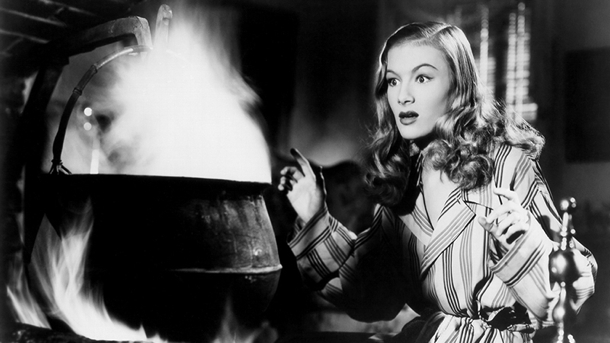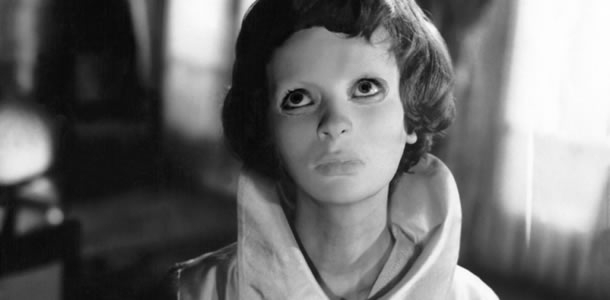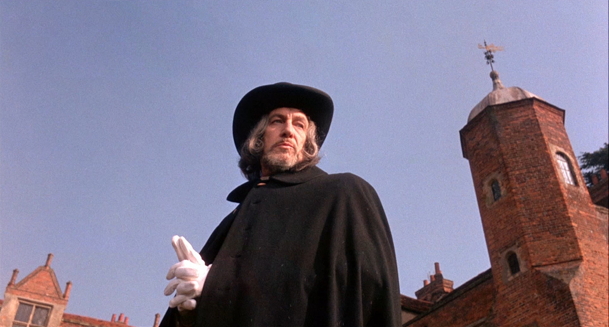HOLLYWOOD HYPERSPACE Staying Scary
In his latest Hollywood Hyperspace column, SFX 's West Coast Editor Joe McCabe gets over Halloween withdrawal in the scariest possible way...

I admit it – I’ve been suffering from Halloween withdrawal lately. It happens every November. After the rush of horror-themed screenings, scare mazes, and parties here in Los Angeles, I inevitably find myself staring into a void every 1 November , crushed by the realisation that there’s nothing much happening on the calendar until Christmas Day except – in America – a celebration of overeating.
What’s a pop culture geek to do?
This year, of course, November is the 50th anniversary of Doctor Who . So sci-fi fans have much to get excited about with An Adventure In Space And Time and Day Of The Doctor on their way. Meanwhile, superhero lovers can enjoy the latest Marvel movie, Thor: The Dark World . (Caught it last Friday night – fun stuff, just don’t expect another Avengers Assemble .) But there’s still that horror hound lurking inside me that wants just a little bit more of the spooky stuff before all is holly and jolly. Here then are a few films I’ve been consuming lately to keep my hound at bay (as well as info for American readers on their home video sources).
Halloween (1978)
John Carpenter made more than the definitive Halloween movie when he fashioned the tale of psychopathic Michael Myers, who, as a six-year-old, stabs his sister and her boyfriend to death and gets locked up in a mental hospital for fifteen years before breaking out and returning to Haddonfield to terrorise a fresh batch of high school students. Among them is final girl Laurie Strode – Jamie Lee Curtis, in her film debut, following in the footsteps of her mom, Psycho star Janet Leigh.
Carpenter, like Steven Spielberg three years before him, made a perfect machine, a thriller in which not one word nor shot is wasted. Like Jaws , Halloween owes a debt to Hitchcock with its lean dialogue and numerous POV shots of characters walking through a suburban Illinois town (in reality, Southern California) standing on the brink of hell. But there’s nothing derivative about the experience. Like so many great films, Halloween remains fresh. It might not have folks shrieking the way it once did (one can only see so many slasher films before one becomes desensitised to this sort of thing), but it remains a must-see because of the wonder its craftsmanship evokes, as well as its influence on everything from A Nightmare On Elm Street to Scream . Some fright fiends swear by a couple of the Halloween sequels, but nothing comes close to the original’s level, which Carpenter himself only again reached with The Thing .
Source: Anchor Bay’s 35th Anniversary Blu-ray does what so many past home video editions of Halloween failed to do. Capturing the full richness of cinematographer Dean Cundey’s autumnal sunset hues, its dreamlike beauty makes the nightmare that much darker. There’s also a great little featurette that finds star Jamie Lee Curtis gamely attending (for charity) her one and only horror film convention.
Weekly digests, tales from the communities you love, and more

I Married A Witch (1942)
On the softer end of the spook spectrum is ex-pat French director Rene Clair’s fable about a witch (Veronica Lake, in her defining screen role) burned at the stake, who returns for vengeance against the descendent (Fredric March) of the Salem Puritan who executed her. Unfortunately, things get complicated when she falls for the fellow… Yes, it’s a sweet film made during a not-so-sweet era (World War II), but there’s more than a pinch of salt that helps make it the perfect romantic comedy for those whose faces light up at the mere sight of a jack o’ lantern. Lake and March supposedly hated each other in real life, but the on-screen chemistry between her sexy spitfire and his fastidious politician is the perfect brew. It’s like Ernst Lubitsch directed a script intended for Frank Capra.
Source: It’s hard to believe Criterion’s new Blu-ray edition is the first time I Married A Witch has been made commercially available in region 1, and its long-awaited arrival makes up for the lack of extras. An audio interview with Clair and a trailer are the only special features. But there’s a great little essay on the film by the great Canadian fantasist Guy Maddin.

Eyes Without A Face (1960)
Another Frenchman, Georges Franju, is responsible for Eyes Without a Face (a.k.a. Les yeux sans visage ) my favorite French-language thriller (with the exception of Les Diaboliques – based on a novel by Eyes screenwriters Pierre Boileau and Thomas Narcejac). Working off of Jean Redon’s acclaimed novel, Franju somehow fuses the beat of the New Wave to the heart of a gothic potboiler. Like Breathless (released the same year), there’s a touch of jazz (thanks to composer Maurice Jarre) beneath the surface of this demented fairy tale; in which a brilliant surgeon, blaming himself for his daughter’s disfigurement, is obsessed with getting her a new face, killing anyone he must in order to do so.
Actress Edith Scob creates her own wonderfully bird-like body language as the daughter, a princess locked in a castle tower if ever there was one. But her mask is one of horror’s most iconic images. So closely does it adhere to her face that it becomes the visage of a cruel ghost, mocking her every emotion. No less a director than Pedro Almodovar borrowed some of Eyes ’ imagery and scenario for his recent The Skin I Live In , but nothing come close to Franju’s once censored, now celebrated wonderwork.
Source: Like I Married A Witch , Eyes just got the Criterion Blu-ray treatment here in the States – the full Criterion treatment, including Franju’s 1949 doc about the slaughterhouses of Paris, Blood Of The Beasts . There are also interviews with Scob and Franju, as well as Boileau and Narcejac, without whose work – including the novel on which Hitchcock’s Vertigo is based – the cinema of suspense would be unfathomably poorer.

The American International Pictures Of Vincent Price
Roger Corman’s Edgar Allan Poe cycle – from The Fall Of The House Of Usher to The Tomb Of Ligeia is beloved horror staple Price’s signature work, but no fan of dear Vincent should deny themself The Abominable Doctor Phibes (1971) and Witchfinder General (aka The Conqueror Worm, 1968). Also released in the States by AIP, they both serve to illustrate just how wide the sometimes critically maligned Price’s range could be.
Directed by frequent Avengers helmer Robert Fuest, the 1971 Phibes blends campiness, early twentieth century pulp fiction, and the Agatha Christie procedural with a surrealism that could only come from the UK of the early ‘70s. It invents a super-villain that’s part Fu Manchu and part Professor Moriarty, but makes him an antihero emblematic of his era, hunting down those he deems responsible for the death of his wife. Seeing as how she’s played – albeit in an embalmed, inert state – by the lovely (and uncredited) Caroline Munro, his vendetta is entirely excusable.
Witchfinder General ’s vibes are 180 degrees from those of Phibes . Here Price plays notorious seventeenth-century witchhunter Matthew Hopkins, a sadistic opportunist whose very real English Civil War horrors – both physically and mentally – echo those of the then ongoing Vietnam War. Twenty-four-year-old writer-director Michael Reeves died several months after its release, sadly denying us of more of his staggering talent. For Witchfinde r is textbook cinema, prefiguring and more disturbing in its implications than both The Last House On The Left and Straw Dogs .
Source: The Abominable Doctor Phibes and Witchfinder General are available in shimmering transfers with actor/filmmaker interviews and full commentaries on Scream Factory’s The Vincent Price Collection , alongside Roger Corman’s The Fall Of The House Of Usher, The Pit And The Pendulum, The Masque Of The Red Death, and The Haunted Palace , all of which are essential viewing for Price fans.

SFX Magazine is the world's number one sci-fi, fantasy, and horror magazine published by Future PLC. Established in 1995, SFX Magazine prides itself on writing for its fans, welcoming geeks, collectors, and aficionados into its readership for over 25 years. Covering films, TV shows, books, comics, games, merch, and more, SFX Magazine is published every month. If you love it, chances are we do too and you'll find it in SFX.


